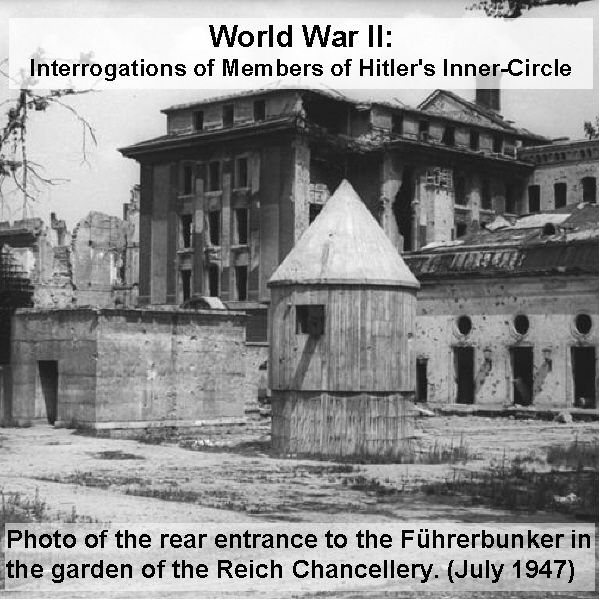
World War II: Interrogations of Members of Hitler’s Inner-Circle
$19.50
Description
Hitler’s Final Days: Eyewitness Accounts
Timeline of Main Events
- November 8, 1923: The Beer Hall Putsch takes place in Munich. (Mentioned by Klosten Glonn)
- Pre-1931: Gottlob Berger develops his initial impressions of Adolf Hitler.
- 1930s: Adolf Hitler rises to prominence within the Nazi Party (NSDAP). (Referenced by Alfred Jodl’s discussion of the Versailles Treaty and the rise of the NSDAP)
- 1931: Gottlob Berger continues to form his impressions of Hitler. Michael Musmanno becomes the youngest judge in the county court of Allegheny County.
- 1937: Major General Schellenberg meets Adolf Hitler for the first time.
- 1939 – 1945: Gerda Christian serves as one of Hitler’s secretaries, with a break in 1942-1943.
- 1940 – 1945: Artur Axmann serves as the Reich Youth Leader (Reichsjugenführer) of the Nazi Party.
- 1943: Admiral Karl Dönitz discusses the development of a new type of submarine in the German Navy.
- July 20, 1944: An attempt is made on Adolf Hitler’s life. (Mentioned by several interviewees)
- Early 1945:General Engel visits Hitler on March 18 or 19, observing his appearance and the men around him.
- General Engel visits Hitler again on April 1, noting Hitler’s reaction to the news of President Roosevelt’s death.
- Julius Schaub is in Hitler’s bunker from April 21 to 25, witnessing the burning of Hitler’s papers.
- April 1945:The final days in the Führerbunker in Berlin. (Discussed by Artur Axmann, Gerda Christian, Traudl Junge, Erich Kempka, Christa Schroder, and Hans Fritzsche)
- Hitler marries Eva Braun. (Mentioned by the source overview and several interviewees)
- Hitler dictates his last will and testament. (Mentioned by Traudl Junge)
- Hitler and Eva Braun commit suicide. (Mentioned by the source overview and several interviewees, including Erich Kempka and Erich Mansfeld)
- The bodies of Hitler and Eva Braun are cremated. (Mentioned by Hans Fritzsche, Erich Kempka, and Erich Mansfeld)
- Joseph Goebbels and his wife also commit suicide and are cremated. (Mentioned by Erich Kempka and Hans Fritzsche)
- Admiral Karl Dönitz becomes the leader of Nazi Germany for 23 days following Hitler’s suicide.
- Post-May 1945: The end of World War II in Europe.
- 1946: Michael Musmanno serves as military governor of an occupied district in Italy.
- 1947: Michael Musmanno serves as a presiding judge for the Einsatzgruppen Trial in Nuremberg.
- 1948: Captain Michael A. Musmanno leads the U.S. investigation to determine if Adolf Hitler died at the end of the war, conducting interviews with numerous members of Hitler’s inner circle with the help of Elisabeth Billig as a simultaneous interpreter.
- 1961: Michael Musmanno testifies as a prosecution witness in Jerusalem at the trial of Adolf Eichmann.
- 1962: An interview is conducted with Veronika Eichmann, the widow of Adolf Eichmann.
Cast of Characters
- Adolf Hitler (1889-1945): Dictator of Nazi Germany. The primary subject of the interrogations, focusing on his final days, suicide, and character.
- Michael A. Musmanno (1897-1968): American jurist, politician, and naval officer who led the U.S. investigation in 1948 to determine if Adolf Hitler died at the end of the war. He conducted the interviews documented in the source.
- Elisabeth Billig: Simultaneous interpreter who assisted Michael Musmanno during the 1948 interrogations.
- Artur Axmann (1913-1996): Reich Youth Leader (Reichsjugenführer) of the Nazi Party from 1940-1945. He was interviewed about the events and people in Hitler’s bunker during the last months of the war.
- Traudl Junge (Gertraud Humps, later Traudl Junge) (1920-2002): One of Hitler’s personal secretaries. She provided detailed accounts of her duties and the last days in the Führerbunker, including Hitler’s marriage, will dictation, and suicide.
- Baron von Loringhoven (Berndt Freytag von Loringhoven) (1914-2007): An aide-de-camp to Hitler who was present in the Führerbunker.
- Albert Speer (1905-1981): Reich Minister of Armaments and War Production for Nazi Germany. His written report details Hitler’s character, work habits, personnel relations, relationship with Eva Braun, and role as supreme commander.
- Martin Bormann (1900-1945?): Head of the Party Chancellery and Hitler’s private secretary. Mentioned in Speer’s report and by Anni Winter.
- Eva Braun (1912-1945): Hitler’s mistress and later his wife. Her relationship with Hitler and her suicide are discussed by several interviewees, including Speer, Anni Winter, Franziska Braun (her mother), Gerda Christian, Traudl Junge, Erich Kempka, and Christa Schroder.
- Franklin D. Roosevelt (1882-1945): President of the United States. His death and Hitler’s reaction to it are mentioned by Speer, Engel, and Krieger.
- Hermann Göring (1893-1946): Commander-in-Chief of the Luftwaffe. Mentioned in Speer’s report.
- Heinrich Himmler (1900-1945): Head of the SS. Mentioned in Speer’s report, by Anni Winter (his association with Hess), Margaret Himmler (his wife), and Schellenberg (Schellenberg’s attempts to remove Hitler with Himmler’s help).
- Wilhelm Keitel (1882-1946): Chief of Staff of the Armed Forces High Command. Mentioned in Speer’s report.
- Anni Winter: Hitler’s housekeeper in Munich. She provided insights into Hitler’s personal life, Eva Braun, other women in his life (including his niece Geli Raubal), Bormann, Hess, Schaub, the destruction of Hitler’s papers, Dr. Morell, and Hitler’s views on the treatment of Jews.
- Gottlob Berger (1896-1975): A high-ranking SS officer. He discussed his impressions of Hitler from 1931 to the end of the war and Hitler’s plans for using prisoners as human shields, as well as the atmosphere in the bunker.
- Hugo Blaschke (1881-1959): Hitler’s dentist. He recounted how he met Hitler and became his dentist.
- Karl Brandt (1904-1948): Hitler’s personal physician, Reich Commissioner for Health and Sanitation, and head of the Nazi euthanasia program. He wrote about the women around Hitler, including Eva Braun, her sisters, Geli Raubal, and Frau Marion Schoenemann.
- Franziska Braun (1885-1952): Eva Braun’s mother. She discussed her daughter’s relationship with Hitler.
- Gerda Christian (1913-1997): One of Hitler’s secretaries. She discussed the last days in the Führerbunker.
- Karl Dönitz (1891-1980): Commander-in-Chief of the German Navy, later briefly Hitler’s successor. He discussed naval warfare, submarines, his actions at the end of the war, and the Italian Navy.
- Veronika Eichmann (née Liebl) (1910-2007): The widow of Adolf Eichmann. Her 1962 interview covers stories about her husband and their children.
- Adolf Eichmann (1906-1962): A major figure in the organization of the Holocaust. His widow was interviewed, and Musmanno testified at his trial.
- General Engel: A German general who visited Hitler in March and April 1945. He described Hitler’s appearance, the people around him, and his reaction to Roosevelt’s death.
- Hans Fritzsche (1900-1953): A senior Nazi in the Propaganda Ministry. He discussed Hitler’s health, suicide, cremation, and jawbone, as well as Goebbels and the final days in the bunker.
- Joseph Goebbels (1897-1945): Reich Minister of Propaganda. His role in the final days and his suicide are mentioned by Fritzsche and Kempka.
- Klosten Glonn: An officer in the Bavarian National Police. He described the events of the Beer Hall Putsch in 1923.
- Margaret Himmler (née Boden) (1893-1967): Wife of Heinrich Himmler. She discussed her husband’s health, workload, reports to Hitler, and the poison he carried, claiming ignorance of concentration camps.
- Alfred Jodl (1890-1946): Chief of the Operations Staff of the Armed Forces High Command. His statement discusses the hardships of the Versailles Treaty and the reasons for the rise of the Nazi Party, as well as Hitler’s decision-making.
- Erich Kempka (1910-1975): Hitler’s chauffeur. He discussed Eva Braun and the suicide and cremation of Hitler and the Goebbels.
- Ludwig Krieger: One of Hitler’s stenographers. He described the stenographers’ work, Hitler’s reaction to Roosevelt’s death, why Hitler carried poison, and how he treated people.
- Erich Mansfeld (alias Eric Skrzipozyk): A guard at Hitler’s bunker. He described the cremation of Hitler and Eva Braun’s bodies.
- Theodor Gilbert Morell (1886-1948): Hitler’s personal physician. His report details Hitler’s health and the drugs he administered.
- Julius (Wilhelm) Schaub (1898-1967): Personal attendant to Hitler. He discussed his job, the bunker in late April 1945, the burning of Hitler’s papers, Hitler’s Munich apartment, his niece Geli Raubal, and the rest of Hitler’s family, denying Hitler ever had a double.
- Walter Schellenberg (1910-1952): A Major General. He described meeting Hitler in 1937, his attempts to convince Himmler to remove Hitler, Hitler’s health, and his belief that Hitler was murdered, not a suicide.
- Christa Schroder (1908-1984): One of Hitler’s personal secretaries. She described her duties, his health, Eva Braun, the last days in the Bunker, her escape, and a suicide plan letter from Eva Braun to her sister.
- Geli Raubal (1908-1931): Hitler’s niece. Mentioned by Anni Winter, Karl Brandt, and Julius Schaub in the context of women in Hitler’s life.
- Frau Marion Schoenemann: Mentioned by Karl Brandt as one of the women around Hitler.
- Werner Haase (1900-1950): Hitler’s personal physician in his final days (mentioned as performing dental work on Hitler’s body for identification). While not explicitly listed as interviewed, Hugo Blaschke was Hitler’s primary dentist.
World War II: Interrogations of Members of Hitler’s Inner-Circle
1,852 pages of English language documentation of interviews of 66 individuals who were interrogated as part of the U.S. investigation, led by Captain Michael Musmanno, to determine if Adolf Hitler died at the end of the war.
Musmanno and several other interviewers conducted personal interviews with Hitler’s secretaries, his dentist, many of the top Reich generals, and other persons who knew of or about Hitler, or was near Hitler in the days leading up to his suicide. In 1948 Michael A Musmanno conducted interviews, with the help of a simultaneous interpreter named Elisabeth Billig. Among those interviewed included the leader of the Hitler Youth, Artur Axmann; Hitler’s secretary, Traudl Junge; and his aide-de-camp, Baron von Loringhoven. Among the many things covered are the Soviet Invasion of Germany, details of everything from the claustrophobic quarters of the Hitler’s underground bunker, the Führerbunker, to his marriage to Eva Braun, to his final meal and eventual suicide. Several interviewees mention the July 20, 1944 attempt on Hitler’s life.
Highlights include:
Albert Speer, Reich Minister of Armaments and War Production for Nazi Germany. Written report by Speer on the character of Hitler. He covers Hitler’s personnel relations with close collaborates, his work habits, his character, his relationship with Eva Braun, his role as supreme commander of the Wehrmacht. Subjects covered: Bormann, Martin; Braun, Eva; Death of Roosevelt; Germany Armed forces; Goering, Hermann; Hitler, Adolf; Himmler, Heinrich, 1900-1945; Keitel, Wilhelm, 1882-1946; Operation Valkyrie.
Anni Winter, Hitler’s housekeeper in Munich, discusses Hitler, Eva Braun, Gehle (Hitler’s niece), the other women in Hitler’s life, Bormann, Hess, Schaub and the destruction of Hitler’s papers, Dr Morell, and Hitler’s version of how the Jews were treated.
Arthur Axmann, Reich Youth Leader (Reichsjugenführer) of the Nazi Party from 1940-1945, discusses the events and people in Hitler’s bunker during the last months of the war.
General Gottlob Berger discusses his impressions of Hitler from 1931 to the end of the war. He also discusses Hitler’s plans for using prisoners as human shields and what it was like in Hitler’s bunker at the end of the war.
Hugo Blaschke, Hitler’s dentist answers questions about how be met Hitler and became his dentist.
Dr. Karl Brandt was Hitler’s personal physician, Reich Commissioner for Health and Sanitation, and headed the administration of the Nazi euthanasia program. He writes about the women around Hitler: Eva Braun and her sisters, Geli Raubal, and Frau Marion Schoenemann.
Franziska Braun discusses her daughter Eva and her relationship with Hitler.
Gerda Christian, Hitler’s secretary from 1939-1942, 1943-1945, discusses the last days in the Fuehrer bunker.
Admiral Karl Dönitz discusses German naval warfare, the new type of submarine developed in 1943, and his actions at the end of the war. In
a second interview he discusses the Italian Navy and why he feels he should not have been condemned. Doenitz was the leader of Nazi Germany for 23 days after Hitler’s suicide in April 1945.
Added to this collection is a 1962 interview of Veronika Eichmann, the widow of Adolf Eichmann. Mrs. Eichmann shares stories of her husband
and their children.
General Engel describes his visits to Hitler on March 18 or 19 and on April 1, 1945. He discusses Hitler’s appearance, the men around Hitler, and Hitler’s reaction to the news of Roosevelt’s death.
Hans Fritzsche, a senior Nazi in the Propaganda Ministry, discusses Hitler’s health, suicide, cremation, and jawbone. He discusses Goebbels and the last days in the bunker.
Klosten Glonn, an officer in the Bavarian National Police, describes the events of November 8, 1923, which are known as the Beer Hall Putsch.
Margaret Himmler, wife of Heinrich Himmler, discusses her husband’s stomach troubles, how busy he was, how often he reported to Hitler, and the poison he carried around with him. She claimed no knowledge of what went on in the concentration camps.
Alfred Jodl, Chief of the Operations Staff of the Armed Forces High Command, in a statement discusses the hardships of the Versailles treaty and the reasons for the rise of the NSDAP (the Nazi Party). He discusses the reasons for Hitler’s decisions.
Mrs. Gertraud (Traudl) Junge, one of Hitler’s secretaries, discusses her duties, her conversations with Hitler, and gives a detailed description of the last days in the bunker. This includes Hitler’s resolve not to leave
Berlin, Eva Braun, the dictation of his will. Mrs. Junge discusses Hitler’s cooks, his diet, and his body guard, Mr. Schaub.
Erich Kempka, Hitler’s chauffeur, discuses Eva Braun and the suicide and cremation of Hitler and the Goebbels.
Ludwig Krieger, one of Hitler’s stenographers, describes the stenographers and how they worked both in Berlin and Berchtesgaden, Hitler’s reaction to the death of Roosevelt, why Hitler carried poison, how Hitler treated people.
Erich Mansfeld, alias Eric Skrzipozyk, a guard at Hitler’s bunker, describes the cremation of the bodies of Hitler and Eva Braun.
Report of Dr. Theodor Gilbert Morell, Hitler’s personal physician, describing Hitler’s health and the drugs Morell administered with descriptions of these drugs.
Julius (Wilhelm) Schaub, personal attendant to Hitler, discusses his job, the bunker from April 21 to 25, 1945, the burning of Hitler’s papers, Hitler’s Munich apartment, Hitler’s niece, and the rest of Hitler’s family. He denied that Hitler ever had a double.
Major General Schellenberg describes meeting Hitler in 1937, his attempts to convince Himmler to remove Hitler from power, Hitler’s health, and his belief that Hitler did not commit suicide, but was murdered.
Christa Schroder, one of Hitler’s personal secretaries, describes her duties, his health, Eva Braun, the last days in the Bunker, her escape to Berchlesgaden, and a letter written by Eva Braun to her sister discussing the plan to commit suicide.
About Michael A. Musmanno
Michael Angelo Musmanno (April 7, 1897 – October 12, 1968) was an American jurist, politician, and naval officer. He went to work as a coal loader in Pennsylvania the age of 14. After serving in the United States Army in World War I, he obtained a law degree from Georgetown University. In 1927, Musmanno volunteered to serve as an appellate attorney for the defendants int he Sacco-Vanzetti case. Musmanno was elected in 1928 as a Republican state legislator for Pennsylvania serving in the Pennsylvania House of Representatives. In 1931, Musmanno became the youngest judge in the county court of Allegheny County.
He entered the United States Navy during World War II as a military attorney. After the war in 1946 he served as military governor of an occupied district in Italy. In 1947, he served as a presiding judge for the Einsatzgruppen Trial in US military court at Nuremberg .In 1948 World War II Captain Michael Musmanno led the U.S. investigation to determine if Adolf Hitler died at the end of the war. In 1951 he was elected as a justice of the Supreme Court of Pennsylvania. In 1961 Musmanno testified as a prosecution witness in Jerusalem in the Israeli trial of Adolf Eichmann.






Related products
-
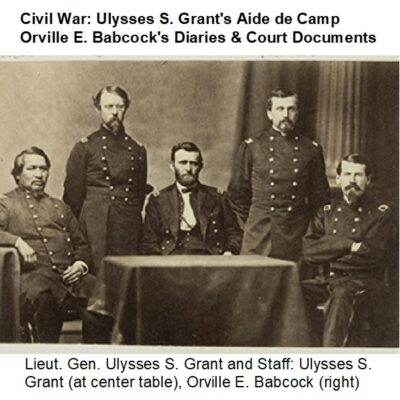
Civil War Ulysses S. Grant’s Aide de Camp Orville E. Babcock’s Diaries & Court Documents
$3.94 Add to Cart -
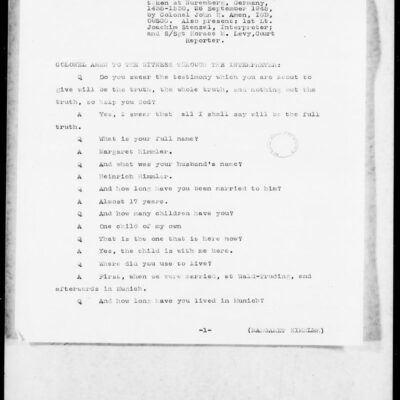
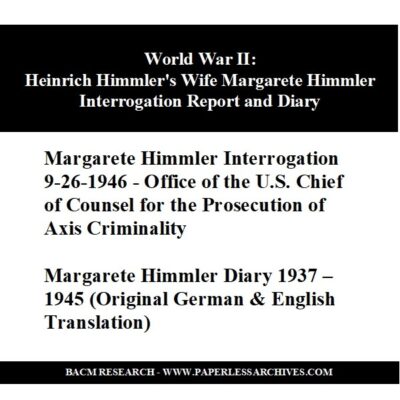
World War II: Interrogation Report and Diary of Margarete Himmler, Wife of Heinrich Himmler
$3.94 Add to Cart -
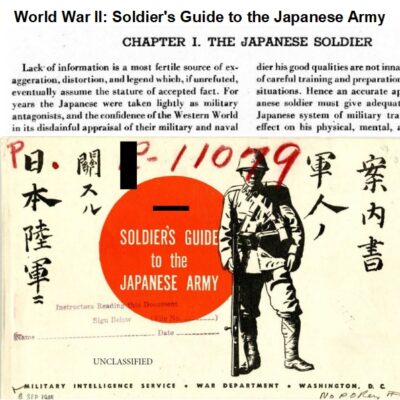

World War II: A Soldier’s Handbook on the Japanese Army
$3.94 Add to Cart -
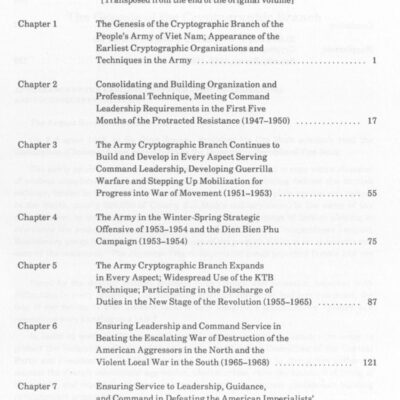
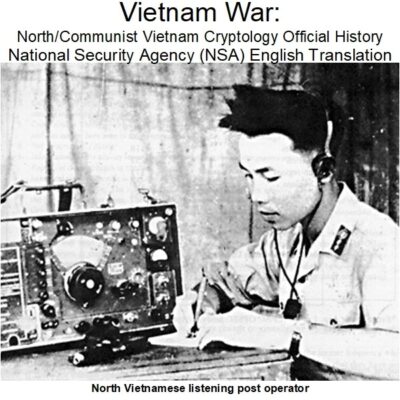
Vietnam War: Cryptology in North Vietnam – NSA Official History
$4.90 Add to Cart